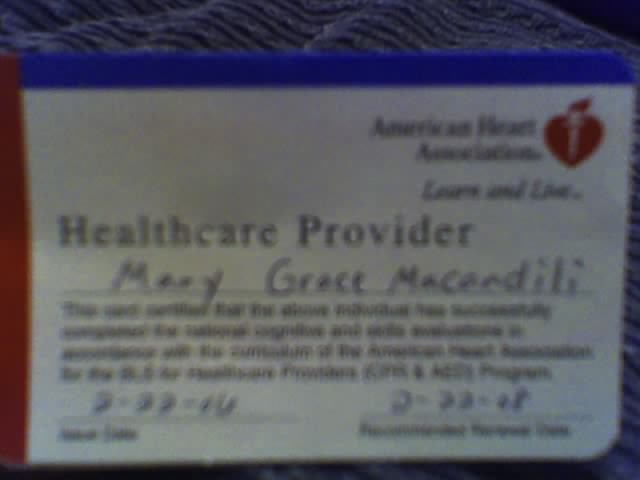2.24.2006
PALS: Pediatric Emergencies
I finished my PALS (pediatric advance life support) course today. I was given my Pin reward for completing the 2 day course in addition to the standard wallet size card certification. Everybody in that room was an emergency nurse. I was the only one who were not from that department. Rounding the table for names and work background, I always joke around and told them I was a lost sheep among wolves. I have worked as a cardiac / stepdown nurse my entire career and I am ready to take on a more challenging position. Taking ACLS was the first step, then PALS to seal my certification toward the career choice that I have wanted. The only missing piece now is the actual full time position on an emergency department. Ok, back to PALS... I hate working with children. Not because i hated children but i just don't have the emotional restriction in caring for children. It just breaks my heart to see a child suffer. I have a child myself which makes it more difficult for me to take care of other children who are sick. I did not want to take this course but as i have said above, i had to if i want an advancement in my career and it also looks good in my resume. Anyway, PALS is much simpler than ACLS as i remember. There are slight differences in BLS procedure, less drugs to memorize and the chain of survival involves prevention of injuries and accidents that may lead to the emergency. This are the summary of the things that i have learned during that course. 1. BLS Procedures
- Check for responsiveness
- Check airway (do not do blind sweep on mouth!)
- Check breathing
- Give 2 full breaths
- Check for circulation
- Give 5 compressions if no pulse
- Alternate 1 breathe and 5 compressions for one whole minute
(with at least 100 bpm)
- Call 911 for assistance
- Use defibrillator if indicated / as needed
2. Chain of Survival
- prevention of injuries or emergencies requiring resuscitation
(VERY IMPORTANT!)
- early CPR
- early defibrillation
- early advanced life support
3. Medications
- coming soon
4. PALS Megacode
- if you need to practice megacodes, i have found a great site for you to practice
http://www.mdchoice.com/cyberpt/pals/pals.asp
5. Important points to consider
- Respiratory cases are more prevalent in pediatrics on acute amercgency situation than cardiovascular cases.
- If you witness a pediatric patient fall down without warning, there's a big chance the case is cardiovascular. But if you dont witness the fall, assume it to be a respiratory case.
- Remember: AIRWAY MANAGEMENT is the very first thing to consider in pediatric emergencies. Open, maintain and support airway!
- Intraosseous site is much better than intravenous site since there is very little or no chance of infiltration.
- Rapid cardiopulmonary assessment is very very important on the first 30 seconds! Learn it by heart!
- Do not forget to treat the cause of emergency first! (Remember your 4H & 4T!)
Posted by nixinne ::
23:52 ::
1 comments

Post a Comment
---------------oOo---------------
2.21.2006
AHA: Basic Life Support [Renewal Course]
 Basic Life Support for Healthcare Providers Basic Life Support for Healthcare Providers
My BLS certification expired last January and technically, I was only allowed to take renewal course 30 days after it expired or else i would have had to take the full 8 hour BLS course. Luckily for me i got in the last renewal class for this month.
It was a 3 hour session with 14 other "students". The first thing we did was to watch a video on the basics. We reviewed the ABCD's of BLS for adults, pediatrics and infants. Heimlich maneuver was also covered for choking victims. The chain of survival for both adults and pediatrics were briefly discussed. The inevitable skills check off came next to the agenda were we were paired 2-3 people in one group. And last but not the least, the BLS test.
I'll talk about each stage whether you like it or not since i do the blog work. For anyone who might stumble in to this blog and finds out that anything is out of line, please let me know so i don't become a mockery of myself.
1. ABCD - this is the mnemonics for airway, breathing, circulation & defibrillation which is crucial in adult and pediatric resuscitation efforts. This is true to healthcare providers but for layperson / non-healthcare providers, checking the circulation or finding the pulse is going to be eliminated by AHA guidelines since it takes too much time for them to find what is necessary thus reducing the time to do the next crucial step of chest compressions. [This statement is according out instructor since AHA will be releasing new guidelines for BLS this coming September 2006]. The following steps is what i have learned for adult CPR. Pediatric CPR mandates the care provider to do CPR first for one minute before calling the EMS. The scenario for all of the following steps is mostly when you are alone on a general public setting.
REMINDER: This entire thing is for the sole purpose of retaining my knowledge and is not intended to be utilized for own personal education or reference. Please refer to professional sites that i will include at the end of this text and also on my links. I will not be liable for any injury that may occur in refering to this blog.
- Check for responsiveness. Do whatever you need to do to make sure the person is not in any way conscious.
- If unresponsive, call 911. When you are on a public setting, there's a lot of bystanders who have access to their cellphone. Make use of them at this time and elt them know that an AED and ambulance is needed right away.
- Check the airway. Look for signs of any foreign objects in the mouth and do blind sweep in the mouth, being careful not to push anything down the throat. Open the airway by doing a head tilt manuever. (Only for professionals) Use jaw thrust manuever if trauma is suspected.
- Check for signs of breathing. Do you feel air coming out from mouth or nose? Do you see the chest rising? If answered yes to both question, the patient is breathing. If not breathing, give 2 rescue breaths while opening the airway.
- Check for circulation. Find the carotid pulse. If absent, start doing 15 chest compressions. Be careful not to do compressions on the xyphoid process to avoid injury to patient. One can find the spot where to do compressions by looking at the nipple alignment and using the center of it to do chest compressions or by followin the ridge of the ribcage towards the xyphoid process and going 3-4 fingers up from there.
- Use the AED or Automatic External Defibrillator. Alternate 15 compressions to 2 breaths. Do the cycle 4 times or for one whole minute then check again for circulation. If AED is present; start the AED, attach electrode pads to appropriate area or as directed, follow instructions as directed by the voice direction system. If shock is indicated, make sure everybody is "clear" or not touching the patient before delivering the shock. The AED will continue to analyze patient 3 times or until it deterines an unshockable rhythm.
- Check your ABC's again and perform CPR if circulation is not present until EMS or the ambulance arrives.
Notes:Before using AED, make sure you check 4 things: [1] Age of patient: AED's mostly have pediatric pads but can only be used for children >1 year old [2] Patient is dry and not on a wet surface [3] Keep pacemakers and AICD's as far away from the electrode pads since it may impede the flow of energy [4] Take off medication patches if present and dry thoroughly before electrode pads are applied
2. Choking & Heimlich Maneuver - The same steps and guidelines are the same for choking victims both adults and children >1 yr old. The universal sign for choking is hand on their neck. Heimlich manuever is used for both age grop while infants <1 yr old needs to have 5 back blows and 5 chest thrusts while stabilizing the neck and the head. [I strongly recommend that anyone who reads this must get their certification or their knowledge from a licensed organization before attempting to help an infant choke victim.]
- Ask the person if he/she is choking, then ask if he/she can cough or talk If the patient responds yes to choking and no to talking r coughing (of course they will do shake their head if theyre not talking, duh!), tell them that you are going to help them, wrap your arms around the person, then make a fist on you right hand, put the flat thumb just above the navel and well below the xyphiod process, hold the right hand with the left hand and do abdominal thrusts until the foreign object is disodged or the pateint becomes unconcious.
- If patient becomes unconscious, Lay the patient slowly down to the floor on a supine position. For adults, do a blind sweep, do a head tilt, attempt 2 rescue breaths, straddle the patient on the thighs and do 5 abdominal thrusts. Alternating 2 rescue breaths and 5 abdominal thrusts until foreign object is dislodged.
Note: If this persists and patient remained unconscious after several attempts, check circulation and begin CPR if needed until EMS arrives.
3. Chain of Survival - These are critical actions that are performed by rescuers that links the victim of cardiovascular emergency to survival.
- ADULTS [1] Early access to EMS or Emergency Medical Services or 911 [2] early CPR [3] eary defibrillation [4] early advanced life support
- PEDIATRICS [1] prevention of injuries or emergencies requiring resuscitation [2] early CPR [3] early defibrillation {4] early advanced life support
Note: Excerpt from Heartsaver CPR for Schools - PDF manual
[americanheart.org - page 4].
I am not going to elaborate the skills check off and the test. It is easy if you truly listen to their subtle (or not so subtle) hints. Mind you, we were laughing at some rumor, at the expense of one cardiologist that failed the first test. He had to take the second test to pass.
---------------------------------------------------------------------------------
American Heart Association
WorldPoint-ECC, Inc
Channing Bete Company
Laerdal Medical Corporation
Posted by nixinne ::
23:55 ::
0 comments

Post a Comment
---------------oOo---------------
2.20.2006
Boomerang™ ClosureWire Vascular Closure System (VCS)
We have been testing this closure device after a cardiac catheterization, PTCA, or stent placement. In a unit like ours who accepts patients with arterial/venous sheaths still in place, we usually take approximately 40 minutes or more of our time just for pulling sheaths and making sure that they don't bleed excessively. This is more time taken from other patients who might need our immediate attention. This particular closure device reduces that time to almost half of the regular alloted time for this type of procedure. And since it is only 19 gauge compared to most arterial sheaths, bleeding is less common than with those who have 5 or 6 French on their groin. So far i really like it, i just hope our facility decides to use the product
Boomerang™ ClosureWire Vascular Closure System (VCS)
Cardiva Medical, Inc.

The Boomerang™ ClosureWire Vascular Closure System (VCS) utilizes a new technique called Arteriotomy Site-Specific Compression.
The Boomerang ClosureWire technique creates a site-specific compression between the inside of the arteriotomy and just outside the tissue tract, resulting in a targeted internal compression of both the arteriotomy and tract. The device is deployed, which creates immediate hemostasis and a secure seal in the cath lab in under 30 seconds. With the device in place, the arteriotomy relaxes back naturally around the Boomerang Wire (0.037 inches) while normal clotting mechanisms begin. Natural elastic recoil of the arteriotomy is known as the Boomerang Effect, which returns the arteriotomy to its original puncture size (approximately a 20 gauge needle). Following the procedure, the device is completely removed, leaving nothing in the artery or tissue tract. Final hemostasis is achieved with just a few minutes of occlusive finger pressure to close the remaining needle puncture site left by removing the Boomerang ClosureWire device.
Courtesy of: MedCompare
Posted by nixinne ::
06:16 ::
0 comments

Post a Comment
---------------oOo---------------
2.15.2006
Charge RNs: Leadership, Appreciation & Resource

I have never been a charge nurse.
I was given an opportunity once but declined the offer for fear of a lot of things. Fear of being hated by peers. Fear of responsibility perhaps.
But i admire people who have the guts to do it. They've got more than compassion, knowledge and nursing skills. They are our resource person, our leader, our helper, our guide. They can be our friend, a confidante, a listener. I seldom meet this kind of charge RN. I certainly found not only one but a lot of them who really cares abot their peers.
The gifts shown above was given to every single nurse on our unit by our charge nurses on Valentine's Day as a token of their appreciation. I was touched by their gesture not by the contents. Not only by the gifts did they show their kindness and concern but also everyday when i come to work. They not only ask how i was but also asks what they can do for me during the shift. It was refreshing and stress free just knowing that you have another soul that cares and appreciates what you do.
I admire all the charge nurses on all health facilities all over the world. Their leadership, knowledge, patience & compassion helps all the other nurses survive what is becoming of them on stressful situations at work.
Posted by nixinne ::
06:55 ::
0 comments

Post a Comment
---------------oOo---------------
|



